
Anaerojar Base, Oxoid
Login to see pricesBrand:
Thermo ScientificTM OxoidTM
Oxoid AnaeroJar Base is a polycarbonate jar base for use with AnaeroJar 2.5L, Part No. AG0025A.
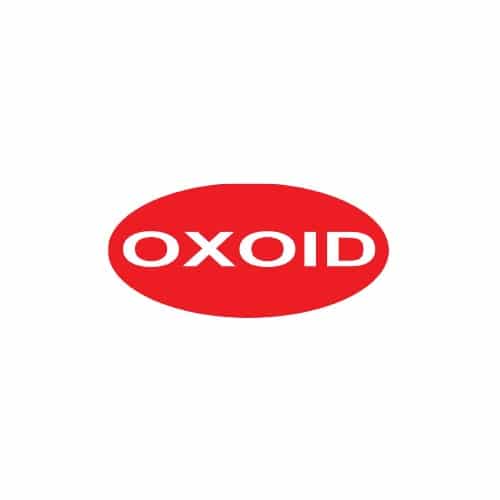
Anaerojar Clips
Login to see pricesBrand:
Thermo ScientificTM OxoidTM
Oxoid AnaeroJar Clip has two self-venting clips. For use with AnaeroJar 2.5L, Part No. AG0025A.
Includes :
2 self-venting clips.

Anaerojar Lid
Login to see pricesBrand:
Thermo ScientificTM OxoidTM
Oxoid AnaeroJar Lid is for use with AnaeroJar 2.5L, Part No. AG0025A.

Anaerojar O Ring
Login to see pricesBrand:
Thermo ScientificTM OxoidTM
Oxoid AnaeroJar O-Ring is for use with AnaeroJar 2.5L, Part No. AG0025A.

Andrades Peptone Water 500g
Login to see pricesBrand:
Thermo ScientificTM OxoidTM
This product has been discontinued. The alternative to this product is Peptone Water.
Oxoid Peptone Water Andrade’s is a nutrient base containing Andrade’s indicator to which carbohydrates and other diagnostic reagents may be added for use in fermentation studies.
Peptone Water Andrade’s, Oxoid Composition
| Typical Formula * | gm/litre |
| Peptone | 10.0 |
| Sodium chloride | 5.0 |
| Andrade’s Indicator (acid-Fuchsin) | 0.1 |
| pH 7.4 ± 0.2 @ 25°C |
Peptone Water Andrade’s, Oxoid Preparation:
Suspend 15 g in 1 litre of distilled water. Mix well to dissolve, distribute into tubes or bottles, containing Durham tubes and sterilize by autoclaving at 121°C for 15 minutes.
Storage conditions and Shelf life
Store the dehydrated medium at 10-30°C and use before the expiry date on the label.
Store the prepared medium in the dark at room temperature.

Anti-acetyl-Histone H3 (rabbit polyclonal)
Login to see pricesBrand:
Merck
Description
Histone H3 is one of the five main histone proteins involved in the structure of chromatin in eukaryotic cells. Featuring a main globular domain and a long N-terminal tail, H3 is involved with the structure of the nucleosomes of the ‘beads on a string’ structure. The N-terminal tail of histone H3 protrudes from the globular nucleosome core and can undergo several different types of epigenetic modifications that influence cellular processes. These modifications include the covalent attachment of methyl or acetyl groups to lysine and arginine amino acids and the phosphorylation of serine or threonine. Acetylation of histone H3 occurs at several different lysine positions in the histone tail and is performed by a family of enzymes known as Histone Acetyl Transferases (HATs). Acetylation of lysine14 is commonly seen in genes that are being actively transcribed into RNA. Research focus area: Epigenetics.
Key Applications:
-Western Blotting
-Immunocytochemistry
-ChIP-seq
-Chromatin Immunoprecipitation (ChIP)
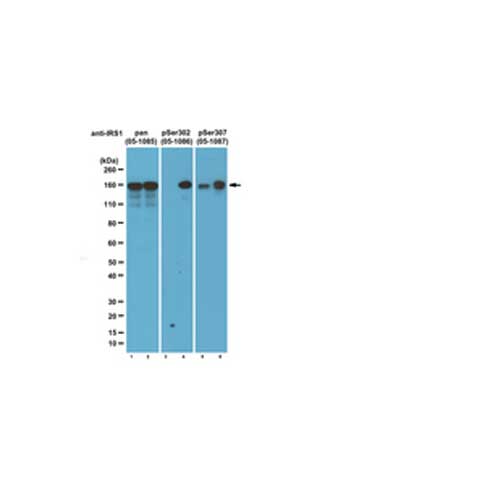
Anti-Actin, clone C4 (mouse monoclonal)
Login to see pricesBrand:
Merck
Description
Actin is an abundant cytoskeletal protein found in all cells (True, 1990). The protein’s 42 kD peptide chain assumes two physical forms: globular actin, which may serve as a cytoplasmic storage pool, and fibrous actin, which, in conjunction with myosin, generates muscle contraction (True, 1990). In non-muscle cells, actin appears to be involved in a variety of functions, such as cell motility, exocytosis, and phagocytosis (True, 1990). Distribution of the six known isoforms of actin – four muscle actins (alpha-skeletal, alpha-vascular smooth, alpha-cardiac, and gamma-enteric smooth) and two cytoplasmic actins (alpha and gamma) is tissue specific (Otey, 1986; Lessard, 1988). Research focus area: Cell Structure
Key Application:
-ELISA
-Immunocytochemistry
-Immunofluorescence
-Immunohistochemistry
-Immunohistochemistry (Paraffin)
-Western Blotting
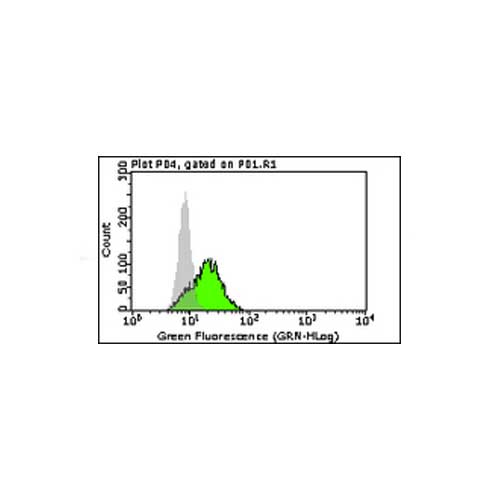
Anti-Glutamate Receptor 2, extracellular, clone 6C4, Alexa Fluor® 488 Conjugate
Login to see pricesBrand:
Merck
Description
Glutamate receptors (GluRs) can be categorized as ionotropic or metabotropic and subcatergorized by their agonist preferences (NMDA, AMPA or Kainic acid). There are four types of AMPA selective GluR subunits (GluR1, GluR2, GluR3 and GluR4). Tetrameric or pentameric combinations of different subunits contributes to the functional diversity of AMPA receptors. In general, AMPA receptors mediate fast synaptic current at most excitatory synapses, with stoichiometry characterized by subtype composition. Although subunit composition of AMPA receptors varies, they must contain at least one edited GluR2 subunit to be calcium impermeable. The critical residue controlling calcium permeability is in the pore loop region. In GluR1, GluR3, and GluR4, this positionis occupied by a Gln residue. In GluR2, it is occupied by an Arg residue. It has been shown experimentally that the presence of Arg in this position blocks CA2+ ion permeability, while a Gln does not. Relative calcium permeability in AMPA receptor channels may be significant in pathological neurotoxic damage and long term changes in nervous system responses. Research focus area: Neuroscience
Key Applications:
-ELISA
-Immunocytochemistry
-Immunohistochemistry
-Immunoprecipitation
-Radioimmunoassay
-Western Blotting

Anti-IRS1, clone 4.2.2 (mouse monoclonal)
Login to see pricesBrand:
Merck
Description
IRS1 (Insulin Receptor Substrate 1) transmits insulin signals via metabolic and mitogenic pathways. IRS1 is heavily phosphorylated on both serine and tyrosine residues. These phosphorylated tyrosines enable IRS to act as a docking protein that binds SH2 domains of such proteins as PI3 Kinase (phosphatidylinositol 3-kinase) and GRB2, resulting in activation. Over expression and phosphorylation of serine is associated with insulin resistance and breast cancer. Some of the more notable phosphorylation sites are Ser302 that is phosphorylated following insulin stimulation. Ser307, phosphorylated by JNK and IKK, is a key regulatory site that appears to disrupt the IRS1/IR interaction and inhibits insulin-mediated activation of the PI3 kinase and MAPK pathways, and Ser636/639 that is known to be phosphorylated by p70S6K downstream of mTOR and acts as a negative feedback loop. Research focus area: Signaling
Key Applications:
-Western Blotting
-Immunoprecipitation
-Immunocytochemistry
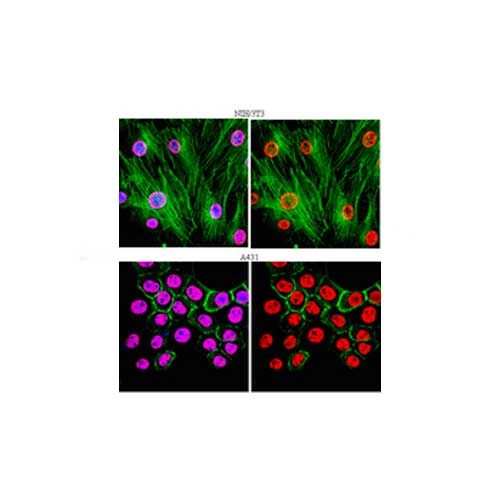
Anti-p62 (Sequestosome-1), clone 11C9.2 (mouse monoclonal)
Login to see pricesBrand:
Merck
Description
p62 is also known as sequestosome-1, and is a 62 kDa ras-GAP associated protein. p62 is thought to bind to src-family tyrosine kinases and may also provide a linker action for activated src-family kinases with their downstream effectors. p62 has an RNA-binding region and may have RNA-binding ability. p62 is associated with activation of transcription factor NF-κB, involved in cell differentiation, immune response and potassium channel regulation. p62 has recently been linked to extrinsic apoptosis and may be a key player in tumorigenesis. Research focus area: Cancer.
Key Applications:
-Western Blotting
-Flow Cytometry
-Immunocytochemistry

Anti-phospho Histone H2A.X (Ser139), clone JBW301, Alexa Fluor® 488 Conjugate
Login to see pricesBrand:
Merck
Description
Histone H2A.X is a variant of histone H2A, and is similarly associated with genomic DNA. However, histone is structurally different from other members of the H2A family in possessing a C-terminal tail that contains the Ser139 residue that is phosphorylated in response to breaks in double-stranded DNA. The phosphorylation of H2A.X is a rapid process that is mediated by ATM/ATR proteins.

Anti-phospho Histone H2A.X (Ser139), clone JBW301, Alexa Fluor® 647 Conjugate
Login to see pricesBrand:
Merck
Description
As a member of the histone H2A family, histone H2A.x (H2A.x) is a variant histone H2A which replaces conventional H2A in a subset of nucleosomes. H2A.x is involved in the DNA repair of double-strand breakage (DSB) damage on nuclear DNA. After a double strand DNA break, H2A.x is rapidly phosphorylated at serine 139 by ATM kinase and becomes gamma-H2AFX. This phosphorylation step can extend up to several thousand nucleosomes from the actual site of the DSB and may mark the surrounding chromatin for recruitment of proteins required for DNA damage signaling and repair. As a part of posttranslational modifications during apoptosis caused by severe DNA damage, high expression of phosphorylated H2A.x is considered as an accurate indicator of apoptosis.
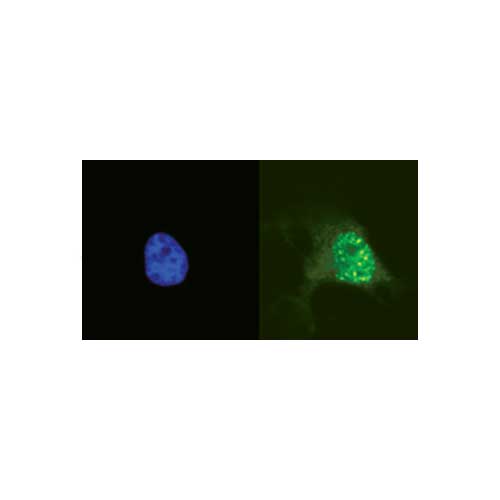
Anti-phospho-Histone H2A.X (Ser139), clone JBW301 (mouse monoclonal)
Login to see pricesBrand:
Merck
Description
Histone H2A is one of the 5 main histone proteins involved in the structure of chromatin in eukaryotic cells. Featuring a main globular domain and a long N terminal tail H2A is involved with the structure of the nucleosomes of the ‘beads on a string’ structure

Anti-phospho-MYPT1 (Thr696) Antibody – Discontinued
Login to see pricesBrand:
Merck
** This product has been discontinued, please contact us for more information.
Description
Myosin phosphatase target subunit 1 (MYPT1), also called Myosin-binding subunit of Myosin phosphatase, is one of the subunits and an integral component of the Myosin phosphatase. Myosin phosphatase regulates the interaction of Actin and Myosin downstream of the guanosine triphosphatase Rho, which inhibits Myosin phosphatase through the action of Rho-kinase. It is also involved in smooth muscle contraction. Inhibition of Myosin light chain phosphatase results in Ca2+ sensitization of smooth muscle contraction. This inhibition is modulated through phosphorylation of MYPT1 by a ZIP-like kinase, which associates with MYPTI and phosphorylates the inhibitory site in smooth muscle. The phosphorylation of MYPT1 by protein kinase C results in altered dephosphoryation of Myosin by attenuating the binding of protein phosphatase 1 catalytic subunit (PP1c) and the phosphorylated 20 kDa Myosin light chain to MYPT1. PP1c interacts with at least four binding sites on the amino-terminus of MYPT1. MYPT1 is localized on stress fibers, and is distributed close to the cell membrane and at cell-cell contacts to regulate Myosin phosphatase activity.

Apr15 Apramycin
Login to see pricesBrand:
Thermo ScientificTM OxoidTM

Arcobacter Broth 500g
Login to see pricesBrand:
Thermo ScientificTM OxoidTM
- Oxoid Arcobacter Broth Base is used for the selective growth of Arcobacter spp.
- Also available CAT Supplement, Part No. SR0174E and CCDA Selective Supplement, Part No. SR0155E and SR0155H.
Arcobacter Broth Base, Oxoid Composition
| Typical Formula * | gm/litre |
| Peptone | 18.0 |
| Yeast extract | 1.0 |
| Sodium chloride | 5.0 |
| pH 7.2 ± 0.2 @ 25°C |
Arcobacter Broth Base, Oxoid Preparation:
Dissolve 12g of Arcobacter Broth in 500ml of distilled water. Sterilise at 121°C for 15 minutes and allow to cool to below 50°C
For use with CAT supplement (SR0174)
Add one vial per 500ml medium of CAT Selective Supplement reconstituted as directed. Dispense into sterile containers.
For use with CCDA supplement (SR0155)
Add one vial per 500ml medium of CCDA Selective Supplement reconstituted as directed. Dispense into sterile containers.
Inoculated plates should be incubated aerobically, at 30°C, for 24 hours.
Storage conditions and Shelf life
Store the dehydrated medium at 10-30°C and use before the expiry date on the label.

Atm30 Aztreonam
Login to see pricesBrand:
Thermo ScientificTM OxoidTM

Azide Blood Agar Base 500g
Login to see pricesBrand:
Thermo ScientificTM OxoidTM
Oxoid Azide Blood Agar Base is a selective media for the detection and isolation of streptococci and staphylococci from feces, sewage and other specimens.
Azide Blood Agar Base, Oxoid Composition
| Typical Formula * | gm/litre |
| Tryptose | 10.0 |
| `Lab-Lemco’ powder | 3.0 |
| Sodium chloride | 5.0 |
| Sodium azide | 0.2 |
| Agar | 12.0 |
| pH 7.2 ± 0.2 @ 25°C |
Azide Blood Agar Base Oxoid Preparation:
Suspend 30g in 1 litre of distilled water and bring to the boil to dissolve completely. Sterilise by autoclaving at 121°C for 15 minutes. For azide blood agar, cool to 45-50°C and add 5% of sterile blood.
Storage conditions and Shelf life
Store the dehydrated medium at 10-30°C and use before the expiry date on the label.
Store prepared blood agar plates of medium at 2-8°C.
Precautions
Proteus and Escherichia species may not always be inhibited on the Edward’s formulation.
Always use a light inoculum for best selective results.
Anaerobic incubation will enhance haemolytic reactions.
Haemolytic reactions will not be typical on Packer’s modification of Azide Blood Agar Base. Streptococcus lactis will not grow on Packer’s modification with 5% sheep blood.
Read the section on Hazard Precautions for azide-containing media.

Azide Dextrose Broth (Rothe) 500g
Login to see pricesBrand:
Thermo ScientificTM OxoidTM
Oxoid Azide Dextrose Broth (Rothe Broth) is used for the detection of enterococciin water, sewage, and food.
Azide Dextrose Broth (Rothe Broth), Oxoid Composition
| Typical Formula * | gm/litre |
| Peptone | 20.0 |
| Glucose | 5.0 |
| Sodium chloride | 5.0 |
| Di-potassium hydrogen phosphate | 2.7 |
| Potassium dihydrogen phosphate | 2.7 |
| Sodium azide | 0.2 |
| pH 6.8 ± 0.2 @ 25°C |
Azide Dextrose Broth (Rothe Broth), Oxoid Preparation:
Add 35.6g to one litre of distilled water for single strength broth or 71.2g for double strength broth. Heat gently to dissolve. Dispense into final containers and sterilise by autoclaving at 121°C for 15 minutes.
Storage conditions and Shelf life
Store the dehydrated medium at 10-30°C and use before the expiry date on the label.
Store the prepared medium at 2-8°C.
Precautions
This product contains less than 1% azide and has low toxicity. However, when handling the powder, wear gloves, mask and eye protection. When washing azide products down sinks, use sufficient water to prevent accumulation of azide in the plumbing.

Azm15 Azithromycin
Login to see pricesBrand:
Thermo ScientificTM OxoidTM
Brand:
Thermo ScientificTM OxoidTM

B10 Bacitracin
Login to see pricesBrand:
Thermo ScientificTM OxoidTM
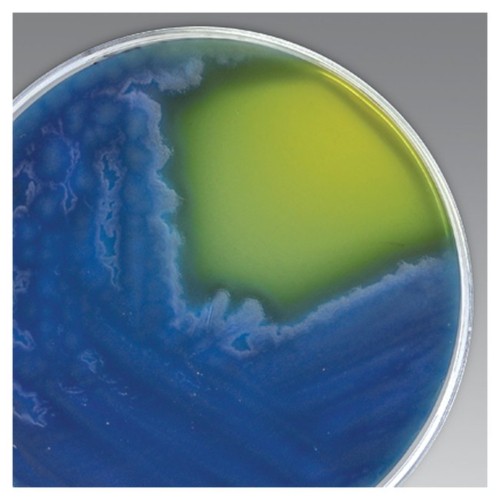
Bacillus Cereus Select Agar Base 500g
Login to see pricesBrand:
Thermo ScientificTM OxoidTM
Selectively isolate and enumerate Bacillus cereus from food samples with Thermo Scientific™ Oxoid™ Bacillus cereus Selective Agar Base (Dehydrated). Bacillus cereus Selective Agar Base meets the requirements for a medium that is sufficiently selective to be able to detect small numbers of Bacillus cereus cells and spores in the presence of large numbers of other food contaminants. The medium is also sufficiently diagnostic that colonies of Bacillus cereus are readily identified and confirmed by microscopic examination.
Bacillus cereus Selective Agar Base, Oxoid Composition
| Typical Formula * | gm/litre |
| Peptone | 1.0 |
| Mannitol | 10.0 |
| Sodium chloride | 2.0 |
| Magnesium sulphate | 0.1 |
| Disodium hydrogen phosphate | 2.5 |
| Potassium dihydrogen phosphate | 0.25 |
| Bromothymol blue | 0.12 |
| Sodium pyruvate | 10.0 |
| Agar | 15.0 |
| pH 7.2 ± 0.2 @ 25°C |
Bacillus cereus Selective Agar Base, Oxoid Preparation:
Suspend 20.5g in 475ml of distilled water and bring gently to the boil to dissolve completely. Sterilise by autoclaving at 121°C for 15 minutes. Cool to 50°C and aseptically add the contents of one vial of Polymyxin B Supplement (SR0099) reconstituted as directed, then add 25ml of sterile Egg Yolk Emulsion (SR0047). Mix well and pour into sterile Petri dishes.
Storage conditions and Shelf life
Store the dehydrated medium at 10-30°C and Polymixin B Supplement at 2-8°C. Use before the expiry date on the label.
The prepared medium may be stored at 2-8°C.
Precautions
On this medium Bacillus cereus is indistinguishable from Bacillus thuringiensis.
Identify Bacillus cereus by colony form, colour, egg yolk hydrolysis and confirm with cell and spore morphology.
Occasional strains of Bacillus cereus show weak or negative egg yolk reactions.

BactiCard E. coli 25TST/KT
Login to see pricesBrand:
Thermo Scientific™ Remel™
Thermo Scientific™ Remel BactiCard E. coli is used for presumptive identification of Escherichia coli using enzyme technology.

BactiCard Neisseria 25TST/KT
Login to see pricesBrand:
Thermo Scientific™ Remel™
Thermo Scientific™ Remel BactiCard Neisseria uses enzyme technology for presumptive identification of pathogenic Neisseria spp. and Moraxella catarrhalis isolated on selective media.

